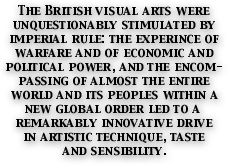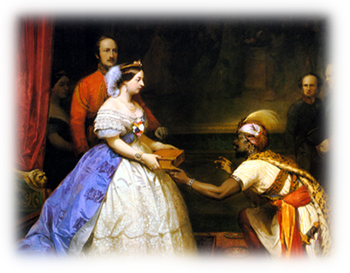Many People use art as a way of coming to terms with their environment, with religious or political ideas, and with social relations. This is particularly true of imperial systems. Members of the dominant group invariably use art as a device to explain and justify their power, to express the mystique of rulers, and to illustrate their knowledge and command of the natural world. Those who find themselves incorporated into empires often pass through phases of adapting their art to that of their political masters, rediscovering the wellsprings of their own art - sometimes as a conscious act of resistance, and, finally, reflecting through their art a new national consciousness.
The history of art in the British Empire illustrates all of these developments. The British visual arts were unquestionably stimulated by imperial rule: the experince of warfare and of economic and political power, and the encompassing of almost the entire world and its peoples within a new global order led to a remarkably innovative drive in artistic technique, taste and sensibility. Europeans who established themselves as permanent settlers in British North America, Australasia, and South Africa embarked upon a search for distinctive artistic expression appropriate to their sense of national identity.
Empire may have stimulated British art, but it disrupted the artistic life of the societies conquered by the British. For most of the Nineteenth Century, the British showed little appreciation of or interest in any part that seemed to differ widely from their own or other European traditions. Indiginous artists could not therefore expect much support or encouragement from their new rulers. At best, what they produced might be collected and displayed as a tool of anthropology rather than for any aesthetic merit. Yet indigenous art survived, whatever Europeans might think of it, as a sort of underground river which was to break surface in the Twentieth Century. Then so-called 'ethnic' art began to attract serious attention of European artists and to influence their work. At the same time artists in Asia, Africa, and the Pacific, as well as drawing on their own artistic traditions, were taking an increasing interest in European froms and techniques and allowing their work to be influenced by them. Thus, within the framework of empire the once rigid divide between western and 'ethnic' art began to break down. However, this process took an inordinate length of time and was to take a series of distinct paths in each of the colonies. There now follows a series of pages that examines the influences and directions taken by artists around the empire.
|


